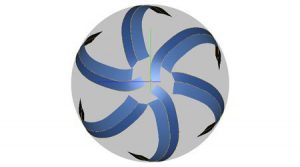Round head cutter in top form
In the field of cutters, the die sinking cutter still occupies a special position. Special cutting edges have constantly met with interestover the last few years. With the new approach in the description of these tools, and also in cutting technology, the new Quinto 5 Software from J. Schneeberger Maschinen AG takes this interest into account. It enables tool developers to define many details of the cutting geometry and the cutting profile as early as in the design phase. In addition, they can view and measure the tool to be made while benefiting from a 3D view of the geometry.

After the basic data such as radius, number of cuts, length and cone angle has been entered, the clamp chamber must be defined. Immediately after entering the parameters, a 3D view of the form and position of the clamp chamber becomes visible and can be adjusted by changing the parameters. The same applies for the clamp chamber in the front area, since the number of centre cuts and the differing behaviour of centre cuts and non-centre cuts play a part here. In the example used, the centre cuts were made in the form of a strong S shape, whereas the other cuts show a conventional path. In addition, the two centre cuts were overlaid with a wave pattern along the entire spiral path. These external variations illustrate just how diverse the design options or tool geometry can be and what tools are now available to tool developers.
Following the design of the tool’s geometry, the calculation of the cutting paths now determines the precise position and orientation of the cutting disc so that all parameters of the tool geometry can be fulfilled. Depending on the size and shape of the cutting disc, these cutting paths can vary greatly, or the operator is asked to use another cutting disc.
